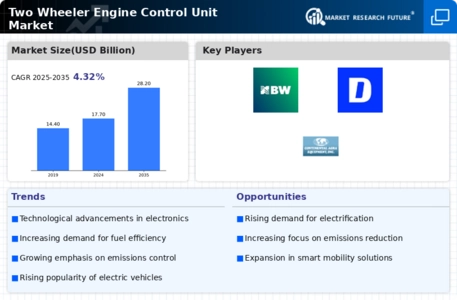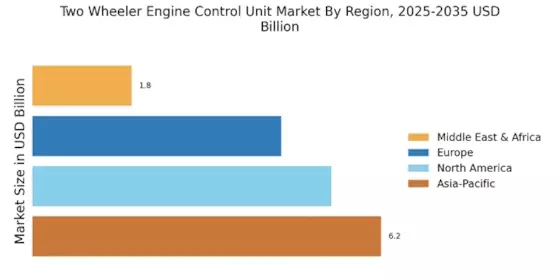Growth of Electric Two Wheelers
The Two Wheeler Engine Control Unit Market is witnessing a notable shift towards electric two-wheelers, which is reshaping the landscape of engine control technologies. As electric vehicles gain traction, the demand for specialized engine control units that manage battery performance, regenerative braking, and energy efficiency is increasing. The market for electric two-wheelers is anticipated to grow at a robust pace, with projections indicating a compound annual growth rate of over 15% in the coming years. This transition not only reflects changing consumer preferences but also highlights the need for innovative control systems that can optimize the performance of electric two-wheelers, thereby driving the Two Wheeler Engine Control Unit Market.
Rising Demand for Fuel Efficiency
The Two Wheeler Engine Control Unit Market is significantly influenced by the rising demand for fuel efficiency among consumers. As fuel prices continue to fluctuate, riders are increasingly seeking two-wheelers that offer better mileage and lower emissions. Engine control units play a crucial role in optimizing fuel consumption by adjusting parameters such as air-fuel mixture and ignition timing. Recent statistics indicate that two-wheelers equipped with advanced engine control units can achieve up to 20% better fuel efficiency compared to traditional models. This trend is likely to propel the market for engine control units, as manufacturers strive to meet consumer expectations for cost-effective and environmentally friendly transportation solutions.
Consumer Preference for Smart Features
The Two Wheeler Engine Control Unit Market is increasingly influenced by consumer preferences for smart features and connectivity in two-wheelers. Modern riders are seeking advanced functionalities such as smartphone integration, navigation systems, and real-time performance monitoring. Engine control units are evolving to incorporate these smart technologies, enhancing the overall riding experience. Data suggests that two-wheelers equipped with smart engine control units are gaining popularity, particularly among younger demographics. This trend is likely to stimulate market growth as manufacturers respond to consumer demands for enhanced connectivity and user-friendly interfaces, thereby propelling the Two Wheeler Engine Control Unit Market into a new era of innovation.
Government Regulations and Emission Standards
The Two Wheeler Engine Control Unit Market is also shaped by stringent government regulations and emission standards aimed at reducing vehicular pollution. Many countries are implementing more rigorous emission norms, compelling manufacturers to adopt advanced engine control technologies. For instance, the introduction of Euro 5 and BS-VI standards has necessitated the integration of sophisticated engine control units that can manage emissions effectively. This regulatory landscape is expected to drive innovation within the market, as companies invest in research and development to comply with these standards. The market is projected to expand as manufacturers seek to enhance their product offerings in response to these regulatory pressures.
Technological Advancements in Engine Control Units
The Two Wheeler Engine Control Unit Market is experiencing a surge in technological advancements, particularly in the realm of electronic control systems. Innovations such as adaptive fuel injection, real-time diagnostics, and advanced sensor integration are enhancing engine performance and efficiency. The integration of artificial intelligence and machine learning algorithms into engine control units is also becoming more prevalent, allowing for improved fuel management and emissions control. According to recent data, the market for advanced engine control units is projected to grow at a compound annual growth rate of approximately 7% over the next five years. This growth is indicative of the increasing demand for high-performance two-wheelers that meet stringent environmental regulations, thereby driving the Two Wheeler Engine Control Unit Market forward.


















Leave a Comment